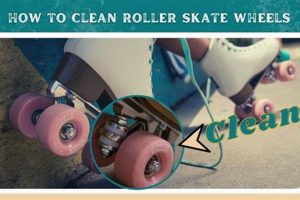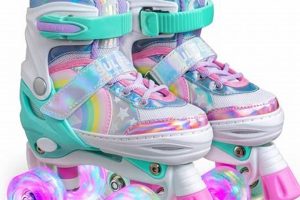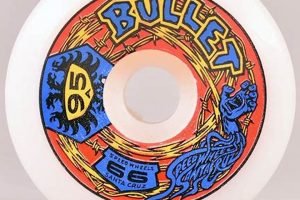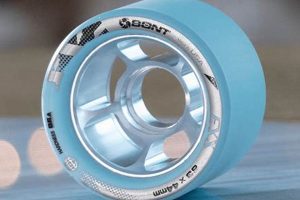Inline skates, characterized by wheels arranged in a line, come in configurations utilizing either three or four wheels. This design difference significantly affects the skating experience, influencing speed, maneuverability, and stability. An example of this distinction is evident when comparing recreational skates, often equipped with four smaller wheels, to speed skates, which may employ three larger wheels for enhanced velocity.
The choice between these two designs impacts performance and suitability for different skating styles. Historically, four-wheel configurations were the standard, offering a balance of stability and control. However, the introduction of three-wheel designs brought advantages in terms of speed and agility, catering to skaters prioritizing these aspects. These attributes are important for skate performance and user experience.
The following sections will delve into a more detailed comparison of the attributes of each design, examining aspects such as speed, maneuverability, stability, wheel size, frame length, and intended use, providing a comprehensive understanding of their respective strengths and weaknesses.
Guidance on Inline Skate Selection
Selecting the optimal inline skate configuration necessitates careful consideration of skating style, skill level, and desired performance characteristics. The following guidance provides insights into the distinctions between three-wheel and four-wheel designs.
Tip 1: Prioritize Stability for Beginners. Individuals new to inline skating may benefit from the enhanced stability offered by four-wheel setups. The increased contact area with the ground provides a more secure and controlled experience, facilitating learning.
Tip 2: Consider Wheel Size for Speed. Three-wheel designs typically accommodate larger wheels. Larger wheels, in turn, generally translate to greater speed and the ability to roll over rougher surfaces more efficiently. This is due to the larger rolling circumference.
Tip 3: Evaluate Maneuverability Needs. Three-wheel skates often exhibit superior maneuverability owing to their shorter frame length. This advantage is particularly useful in environments requiring quick turns and agile movements.
Tip 4: Assess Intended Use. Recreational skaters may find four-wheel skates suitable for casual skating and fitness purposes. Speed skaters and those engaging in more aggressive styles often gravitate towards three-wheel designs for performance benefits.
Tip 5: Factor in Frame Length. Shorter frames, common in three-wheel configurations, contribute to increased responsiveness. Longer frames, typical of four-wheel designs, offer greater stability at higher speeds.
Tip 6: Check Wheel Hardness (Durometer). Softer wheels offer more grip, while harder wheels roll faster and last longer. Consider the surface you will be skating on when selecting wheel hardness.
Tip 7: Maintain Equipment Regularly. Regardless of the wheel configuration, consistent maintenance, including cleaning bearings and replacing worn wheels, is crucial for optimal performance and safety.
In summary, the decision between three-wheel and four-wheel inline skates should align with individual preferences and objectives. Recognizing the distinct attributes of each design will contribute to a more enjoyable and effective skating experience.
The subsequent sections will further explore specific aspects related to performance and application to provide a more in-depth understanding.
1. Speed
The speed attainable on inline skates is directly influenced by the wheel configuration, specifically the choice between three wheels versus four. Three-wheel skates typically accommodate larger wheel diameters. Larger wheels possess a greater circumference, enabling them to cover more ground per rotation, inherently increasing potential speed. This configuration often translates to less energy expenditure to maintain a specific velocity due to reduced rolling resistance. An example of this application can be observed in speed skating events, where athletes commonly utilize three-wheel skates to maximize their velocity over extended distances.
Four-wheel skates, traditionally featuring smaller wheels, may not reach the same peak speeds as their three-wheeled counterparts. However, they can provide a more responsive feel and are generally favored for recreational skating where acceleration and maneuverability are often prioritized over top-end speed. Furthermore, the distribution of weight across four wheels can contribute to a more stable platform, especially for skaters who may lack the advanced balance skills required to efficiently handle the larger wheels common in three-wheel setups. For instance, a skater navigating urban environments with frequent stops and starts might prefer the nimble responsiveness of a four-wheel skate, even if it means sacrificing some speed potential.
In summary, the choice between three and four-wheel inline skates for speed depends on the skater’s goals and skill level. Three-wheel skates offer a distinct advantage in maximizing velocity, particularly over longer distances, while four-wheel skates provide a balanced approach suitable for recreational use and environments demanding agility. Understanding this tradeoff is critical when selecting the optimal skate configuration.
2. Maneuverability
Maneuverability, defined as the ease and quickness with which a skater can change direction or navigate obstacles, constitutes a critical performance characteristic differentiating three-wheel and four-wheel inline skates. The configuration directly influences the skate’s responsiveness and agility.
- Frame Length’s Impact
Frame length is a primary determinant of maneuverability. Three-wheel skates typically feature shorter frames compared to four-wheel skates. This reduction in length concentrates the skater’s weight, facilitating quicker turns and enhanced agility. An example is evident in slalom skating, where shorter frames enable rapid transitions between cones, a task more challenging with the extended wheelbase of a four-wheel skate. The implications are that skaters prioritizing tight turns and immediate response should consider three-wheel models.
- Wheelbase and Turning Radius
The wheelbase, the distance between the front and rear wheels, influences the turning radius. Shorter wheelbases, characteristic of three-wheel setups, allow for tighter turning circles. This advantage is noticeable when navigating crowded environments or executing intricate maneuvers. Conversely, a longer wheelbase, inherent in four-wheel skates, provides a more stable platform but necessitates wider turns. Imagine a skater navigating a crowded boardwalk; the three-wheel setup will offer greater ease in avoiding pedestrians and obstacles.
- Wheel Size Influence
While frame length is paramount, wheel size also plays a role. Three-wheel skates often utilize larger wheels, which, despite their potential for speed, can sometimes hinder maneuverability in very tight spaces. Four-wheel skates, with smaller wheels, offer a lower center of gravity, contributing to stability and a more controlled feel during sharp turns, especially for less experienced skaters. Consider a skater learning to execute crossovers; the lower profile of the four-wheel skate may provide a more confidence-inspiring platform.
- Skater Skill and Control
The inherent maneuverability of a skate is further modulated by the skater’s skill level. An experienced skater can compensate for a longer wheelbase through advanced techniques, while a novice might find the responsiveness of a three-wheel skate challenging to control initially. For instance, a seasoned skater might confidently navigate a skate park on four-wheel skates, whereas a beginner could benefit from the shorter frame of a three-wheel design to develop fundamental turning skills.
In summary, maneuverability in inline skates is a function of frame length, wheelbase, wheel size, and the skater’s proficiency. Three-wheel skates generally offer superior agility and responsiveness due to their shorter frames, while four-wheel skates provide a more stable and controlled feel, particularly beneficial for beginners. The optimal choice hinges on the skater’s skill, intended use, and the specific demands of the skating environment.
3. Stability
Stability, in the context of inline skates, pertains to the resistance against unintended movements and the maintenance of balance. The configuration of wheels, specifically whether a skate utilizes three or four, directly impacts this attribute. A four-wheel configuration generally provides a broader base of support, distributing the skater’s weight more evenly. This distribution reduces the likelihood of instability, particularly during initial push-off and at lower speeds. For example, a skater navigating uneven pavement will likely experience greater stability with four wheels due to the increased contact points with the surface. The effect is a smoother ride and a reduced risk of falls, which is particularly relevant for novice skaters.
However, the stability equation extends beyond the number of wheels. Factors such as wheel size, frame length, and the skater’s center of gravity also play significant roles. While four-wheel skates offer a wider base, three-wheel designs often incorporate larger wheels, which can contribute to a higher center of gravity. This can, paradoxically, reduce stability if the skater lacks sufficient balance and control. Consider a skater transitioning from a standstill to a rolling start; the four-wheel configuration provides a more grounded and secure feel, minimizing the potential for wobbling or loss of balance. This is in contrast to a three-wheel setup, which may require greater core strength and balance to initiate movement smoothly.
In summary, while four-wheel inline skates generally offer enhanced inherent stability due to their wider base of support, the actual stability experienced depends on a complex interaction of factors, including wheel size, frame design, and the skater’s skill level. The practical significance of this understanding lies in the ability to select a skate configuration that aligns with an individual’s skating proficiency and the intended skating environment, optimizing both safety and performance. A less experienced skater navigating varied terrains will likely benefit most from the stable platform afforded by a four-wheel configuration, while a seasoned skater may sacrifice some stability for the increased speed and maneuverability of a three-wheel setup.
4. Wheel Size
Wheel size represents a critical factor in differentiating three-wheel and four-wheel inline skates, directly influencing speed, maneuverability, and the overall skating experience. Its selection impacts performance characteristics and suitability for various skating styles.
- Speed and Roll Efficiency
Larger wheels, often found in three-wheel configurations, inherently possess a greater circumference, enabling increased distance covered per revolution. This translates to higher potential speeds and improved roll efficiency, reducing the energy expenditure required to maintain a given velocity. For instance, speed skaters typically utilize larger wheels for optimal performance in competitions. The implications are that three-wheel skates tend to excel in situations where maximizing speed is paramount.
- Maneuverability and Agility Trade-off
While larger wheels enhance speed, they can, to a degree, compromise maneuverability, particularly in tighter spaces. Smaller wheels, typically used in four-wheel configurations, offer increased agility and responsiveness, facilitating quicker turns and enhanced control. Urban skaters navigating crowded environments might prioritize the maneuverability afforded by smaller wheels. The trade-off underscores the need to align wheel size with the intended skating environment.
- Shock Absorption and Terrain Adaptation
Larger wheels provide superior shock absorption, enabling skaters to traverse rougher surfaces with greater ease and comfort. This attribute is particularly beneficial for skaters encountering uneven pavement or trails. Conversely, smaller wheels transmit more surface irregularities to the skater, requiring greater effort to maintain balance and control on challenging terrains. For instance, a skater transitioning from smooth asphalt to a textured bike path would experience a more comfortable ride with larger wheels.
- Weight and Energy Expenditure
Larger wheels generally weigh more than smaller wheels. While the individual weight difference may seem negligible, when multiplied by three or four wheels and factored into prolonged skating sessions, the cumulative effect can be significant. Skaters may experience increased fatigue with heavier wheels, potentially impacting endurance. The selection of wheel size must therefore consider the skater’s fitness level and the anticipated duration of skating sessions.
In summary, wheel size plays a pivotal role in determining the performance characteristics of inline skates. Three-wheel skates often leverage larger wheels for enhanced speed and terrain adaptation, while four-wheel skates typically utilize smaller wheels to optimize maneuverability and control. The decision between these configurations hinges on the skater’s specific needs, preferences, and the demands of the skating environment. Understanding these nuances is critical for making an informed selection.
5. Frame Length
Frame length, the distance between the front and rear wheel axles on inline skates, profoundly impacts handling characteristics. The relevance of frame length becomes particularly pronounced when comparing three-wheel and four-wheel configurations, as it directly affects stability, maneuverability, and energy transfer efficiency.
- Maneuverability and Responsiveness
Shorter frames enhance maneuverability. Three-wheel skates often utilize shorter frames, enabling quicker turns and improved responsiveness, especially advantageous in confined spaces or during slalom skating. A shorter frame concentrates the skater’s weight, facilitating rapid direction changes. The implications are that skaters prioritizing agility may prefer configurations with reduced frame lengths.
- Stability at Speed
Longer frames inherently offer greater stability, particularly at higher speeds. Four-wheel skates typically feature longer frames, distributing the skater’s weight over a larger area. This distribution minimizes wobbling and enhances control during rapid movement. A longer frame provides a more predictable and stable platform, crucial for maintaining balance when accelerating or navigating uneven surfaces. Thus, speed skaters or those prioritizing high-speed stability often select skates with extended frame lengths.
- Energy Transfer and Efficiency
Frame length influences the efficiency of energy transfer from the skater to the wheels. Shorter frames, while agile, may exhibit increased flex, potentially dissipating some of the skater’s energy. Longer frames provide a stiffer platform, maximizing energy transfer and enhancing propulsion efficiency. Consider a skater executing a powerful stride; a stiffer, longer frame will translate a greater proportion of that force into forward motion. Consequently, frame length affects overall skating efficiency and endurance.
- Wheelbase and Turning Radius
Frame length directly determines the wheelbase, the distance between the frontmost and rearmost wheels. A shorter wheelbase, common in three-wheel setups, yields a tighter turning radius, facilitating sharper turns. A longer wheelbase, typical of four-wheel skates, necessitates wider turns. A skater navigating a crowded urban environment will find the shorter wheelbase of a three-wheel skate more conducive to avoiding obstacles. The selection of frame length must therefore account for the intended skating environment and the desired turning capabilities.
In summary, frame length constitutes a crucial determinant of inline skate performance, particularly when distinguishing between three-wheel and four-wheel configurations. The optimal frame length balances maneuverability and stability, depending on the skater’s skill level, skating style, and intended use. Skaters should consider these factors carefully when selecting equipment to optimize their skating experience.
6. Weight
The overall weight of inline skates is a significant factor influencing skater fatigue, agility, and performance. The distribution of this weight, and the specific components contributing to it, differ between three-wheel and four-wheel inline skate configurations, impacting skater experience and skating style.
- Wheel Count and Material Contribution
The sheer number of wheels adds to the overall weight. A four-wheel setup inherently carries the weight of one additional wheel compared to a three-wheel design. While individual wheel weight may seem minimal, the cumulative effect, particularly during prolonged skating sessions, can contribute to increased fatigue. Furthermore, the material composition of the wheels (e.g., polyurethane durometer, core material) influences weight. Higher-performance wheels, optimized for speed or grip, often incorporate lightweight materials to mitigate weight increases associated with size or construction. The implications are that three-wheel skates, by default, present a potential advantage in minimizing total weight stemming from wheel count.
- Frame Construction and Material Density
The skate frame, typically constructed from aluminum, carbon fiber, or reinforced polymers, constitutes a substantial portion of the overall weight. Three-wheel frames, often designed to accommodate larger wheels, may utilize less material overall due to the reduced wheel count, potentially leading to a lighter frame. However, the material density and structural design play a crucial role. A lightweight carbon fiber frame, irrespective of wheel configuration, will generally weigh less than a heavier aluminum frame. Frame weight affects responsiveness and energy transfer; lighter frames promote agility, while heavier frames may offer greater stiffness. Therefore, frame material and design considerations can negate or amplify the weight differences associated with wheel configuration.
- Bearing Systems and Associated Hardware
The bearing system, consisting of bearings, spacers, and associated hardware, contributes incrementally to the total weight. Although the weight contribution of individual bearings is minimal, the multiplication across all wheels affects the overall load. High-performance bearings, often incorporating lightweight materials or precision engineering, can slightly reduce weight compared to standard bearings. However, the primary impact of bearing weight lies in its effect on rolling resistance rather than the overall skate weight. The implications are that bearing selection is more critical for optimizing speed and efficiency than for minimizing weight differences between three-wheel and four-wheel setups.
- Boot Design and Material Composition
The skate boot, encompassing the shell, liner, and closure system, represents a substantial portion of the overall weight. High-performance boots often utilize lightweight materials like carbon fiber or composite materials to reduce weight and enhance responsiveness. The boot’s design, including the height and stiffness of the cuff, also affects weight. A minimalist boot design, prioritizing weight reduction, may offer less ankle support compared to a more robust, heavier boot. Boot weight impacts skater comfort, agility, and stability. Selecting a boot that balances weight reduction with adequate support and comfort is paramount, irrespective of the wheel configuration.
In conclusion, the weight of inline skates is a multifaceted consideration influenced by wheel count, frame construction, bearing systems, and boot design. While three-wheel configurations present a potential weight advantage due to fewer wheels, the overall weight difference can be mitigated or amplified by material selection and design choices. The optimal skate weight balances performance characteristics with skater comfort and endurance, aligning with individual skating goals and preferences. This highlights the importance of considering all components, not just wheel configuration, when assessing the impact of weight on skating performance.
7. Surface Type
The type of surface upon which inline skates are used constitutes a critical factor influencing the optimal wheel configuration, specifically whether a three-wheel or four-wheel setup is most suitable. Surface characteristics, such as smoothness, roughness, presence of debris, and incline, directly impact the skater’s speed, stability, and maneuverability. Smooth, well-maintained surfaces, like those found in indoor skating rinks or on freshly paved bike paths, offer minimal resistance and allow for efficient rolling. In such environments, the advantages of larger wheels, often associated with three-wheel skates, become more pronounced, facilitating higher speeds and sustained momentum. For example, a speed skater training on a velodrome would preferentially use a three-wheel configuration to maximize velocity. The selection of wheel configuration should thus factor in the prevailing surface conditions to optimize performance.
Conversely, rougher surfaces, such as those encountered on city streets or poorly maintained trails, introduce significant challenges. Uneven pavement, cracks, and small debris increase rolling resistance, reduce stability, and elevate the risk of falls. In these conditions, a four-wheel configuration with smaller, more numerous wheels can provide improved stability and shock absorption. The increased contact area between the wheels and the surface distributes the skater’s weight more evenly, mitigating the impact of surface irregularities. Consider a recreational skater navigating a city sidewalk; the four-wheel setup will offer a more comfortable and controlled experience. Furthermore, the composition of the surface (e.g., asphalt, concrete, wood) influences the optimal wheel durometer (hardness). Softer wheels provide better grip on slick surfaces, while harder wheels offer greater durability on abrasive surfaces. Surface type and material composition, in conjunction with wheel configuration, determine the overall skating experience and safety.
In summary, the interaction between surface type and inline skate configuration represents a crucial determinant of skating performance and safety. Three-wheel skates, with their larger wheels, excel on smooth surfaces where speed is prioritized, while four-wheel skates provide enhanced stability and shock absorption on rougher terrains. Selecting the appropriate wheel configuration based on the anticipated skating environment and the characteristics of the surface ensures a more enjoyable and efficient skating experience. Understanding these considerations allows skaters to adapt their equipment choices to optimize performance and minimize risks, ensuring compatibility between skate design and the environmental conditions.
Frequently Asked Questions
The following addresses common inquiries regarding the selection of three-wheel versus four-wheel inline skates, providing objective information to aid in informed decision-making.
Question 1: Is one wheel configuration definitively superior for all skaters?
No, there is no universally superior configuration. The optimal choice depends on skating style, skill level, and intended use. Three-wheel skates often excel in speed and maneuverability, while four-wheel skates typically offer greater stability, particularly for beginners.
Question 2: Do larger wheels inherently equate to faster skating?
Generally, yes. Larger wheels cover more ground per revolution, enabling higher potential speeds. However, factors such as wheel durometer (hardness), bearing quality, and skater technique also significantly influence speed.
Question 3: Are three-wheel skates more difficult to control than four-wheel skates?
Potentially, especially for novice skaters. The shorter frame length and larger wheels of three-wheel skates can require greater balance and control. Four-wheel skates often provide a more stable and predictable platform.
Question 4: Can wheel configuration compensate for poor skating technique?
No, wheel configuration cannot substitute for proper technique. While specific configurations may enhance certain aspects of performance, fundamental skills such as balance, stride, and braking remain essential regardless of wheel arrangement.
Question 5: Is maintenance frequency different between three-wheel and four-wheel skates?
Maintenance requirements are generally similar. Both configurations require regular cleaning and lubrication of bearings, as well as periodic wheel rotation or replacement. However, the frequency may vary depending on usage intensity and environmental conditions.
Question 6: Does the price point differ significantly between three-wheel and four-wheel skates?
Price variation is more closely linked to brand, materials, and features than solely to wheel configuration. While specialized high-performance skates, regardless of wheel number, may command premium prices, comparable models within each configuration often exhibit similar price ranges.
In summary, the selection of inline skate wheel configuration should be based on a thorough assessment of individual needs and preferences, considering factors beyond simplistic assumptions about superiority or difficulty.
The subsequent sections will discuss the history and evolution of inline skate technology.
Conclusion
The preceding analysis delineates the critical distinctions between “3 wheel vs 4 wheel inline skates,” emphasizing their respective strengths and weaknesses across diverse performance metrics. The exploration encompasses considerations of speed, maneuverability, stability, wheel size, frame length, weight, and surface compatibility, illustrating that no single configuration universally satisfies all skating requirements. The optimal selection remains contingent upon the skater’s skill level, intended application, and the environmental conditions encountered.
Therefore, informed decision-making necessitates a comprehensive understanding of these tradeoffs. Skaters are encouraged to critically evaluate their individual needs and preferences prior to selecting equipment, acknowledging that the ideal inline skate configuration represents a carefully considered compromise, tailored to maximize performance within a specific context. Further research into specific skate models and consultation with experienced skaters or retailers can facilitate a more nuanced and personalized equipment selection process.







